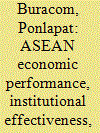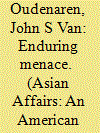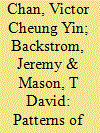|
|
|
Sort Order |
|
|
|
Items / Page
|
|
|
|
|
|
|
| Srl | Item |
| 1 |
ID:
134440


|
|
|
|
|
| Summary/Abstract |
Foreign direct investment (FDI) is considered to be one of the most important forces of economic growth and globalization. Many ASEAN economies have only a small domestic market; they are heavily reliant on international trade and FDI. Recent studies on cross-border investment indicate the importance of domestic economic performance and institutional effectiveness (including government effectiveness, regulatory quality, rule of law and property rights protection) in attracting FDI. The result from a cross-national empirical analysis, in this study, also confirms the significant impact of macroeconomic performance and institutional factors on FDI flows into developing countries. In this paper, it is argued that, with the exception of Singapore, most ASEAN countries are afflicted with relatively poor institutions for good governance, with low government effectiveness, and poor regulatory quality and rule of law. This relatively poor institutional quality may exacerbate the effects of external threats. As higher economic growth and better economic integration in other regions may divert FDI flows into ASEAN countries, their appropriate response is to improve institutional quality so that the share of FDI will increase in the total FDI inflows. Improving the institutional environment among ASEAN member countries should, therefore, be an important goal of ASEAN economic integration.
|
|
|
|
|
|
|
|
|
|
|
|
|
|
|
|
| 2 |
ID:
134441


|
|
|
|
|
| Summary/Abstract |
Since the 1980s, Hong Kong triad societies have evolved from hierarchical, pyramidal organizations to loose, compartmentalized syndicates that retain a modicum of hierarchy. Changes in triad organization and modus operandi occurred in response to stringent anti-organized crime measures enacted in Hong Kong. However, organizational evolution has facilitated triad transplantation to China and improved triads’ ability to engage in transnational crime. Triads have exploited favorable circumstances in China: prevalent corruption, rapid urbanization, and high demand for illicit goods and services. This paper includes two case studies of the Sun Yee On triad. The first examines Sun Yee On's localized activity by tracing the evolution of one Shenzhen area chapter. The second case study examines Sun Yee On's role as a supplier of methamphetamine precursor chemicals to Mexico's Sinaloa cartel. Sun Yee On exemplifies how modern triads have become hybridized, assuming attributes of both local Chinese organized crime and transnational criminal networks.
|
|
|
|
|
|
|
|
|
|
|
|
|
|
|
|
| 3 |
ID:
134439


|
|
|
|
|
| Summary/Abstract |
Since the Tiananmen Square protests of 1989, there have been no national protest movements in the People's Republic of China (PRC). This is the longest period in the history of the PRC without a major national protest movement. Nonetheless, the number of small, local protests or “mass incidents” (as they are termed by the Chinese government) has increased from 9,000 a year in 1994 to over 180,000 in 2010. Most of these incidents target local party and government agencies and/or local firms. Protests by peasants are often motivated by land confiscation by local governments, while worker protests are often over firm treatment of works (including pay, benefits, and job security). More general protests arise over what participants perceive as unfair and illegal extractions of fines, fees, and other payments by local government and party units. We present a theoretical argument on how grievances and mobilization capacity affect the likelihood of protests occurring in a locale. We then test propositions derived from this theory with provincial level data for the period 1995–2010. This study represents one of the first to test predictors of the frequency of mass incidents at the province level.
|
|
|
|
|
|
|
|
|
|
|
|
|
|
|
|
|
|
|
|
|